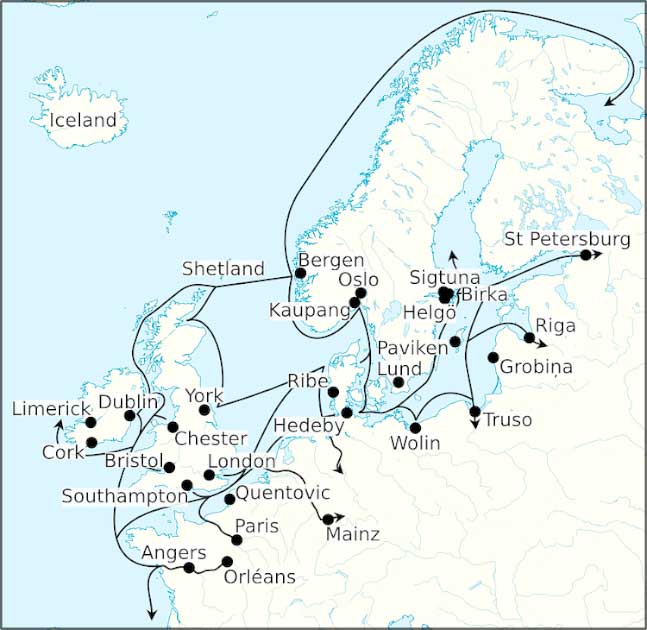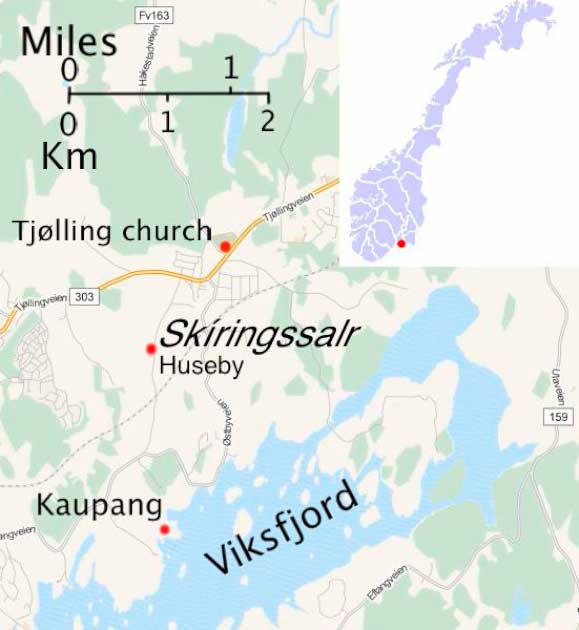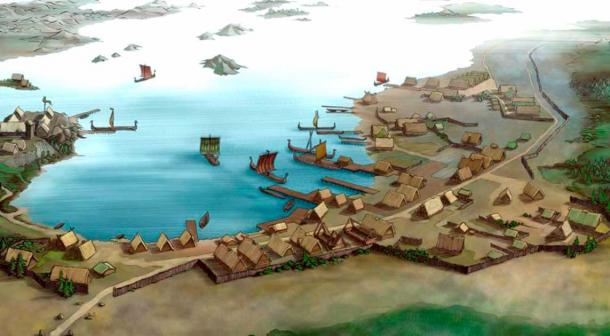
An Archaeological Needle in the Haystack: The Viking Village of Kaupang
Ancient Norse literature is filled with place names of towns, farms, and fjords. While many of these names have survived to the modern day, making their discovery relatively straightforward, others have faded into obscurity. Kaupang, a harbor town supposedly located within the larger district known in the literature as “Skiringssal,”, Norway is one such example. Centuries of research and exploration went into locating the “legendary” Viking Kaupang settlement referenced in Ohthere’s Voyage, which added greatly to our understanding of Norse history. But what finally led the searchers to the lost Viking location?
Kaupang Based on Ohthere’s Voyage and the Seven Books
Scholars researching ancient Norse history have heavily analyzed Paulus Orosius’ (a fifth-century priest) Seven Books. First written in the fifth century, the books were authored to counter claims made by other religious groups that the spread of Christianity had resulted in tragedy and calamity throughout the world. The history was translated and updated with more information in the late 9th century during King Alfred’s reign in support of emerging Anglo-Saxon ideals.
It is in this updated version that we find Ohthere’s Voyage, an account of Viking explorer Ohthere of Hålogaland’s journeys to the White Sea, England, and Denmark. Ohthere mentions a port he calls (translated) “Sciringes-heal.” From other Old Norse literature, we know that Skiringssal was related to the Yngling dynasty, a historically significant line of Norwegian kings. These sources, however, describe Skiringssal as a district, not a singular location.
Despite numerous references in various sources, the location of Skiringssal and the port noted by Ohthere remained a mystery for a very long time, as did the question of what exactly it/they were. Scholars delved deeper into Norse history, and it would take over two hundred years of research to unravel the mystery.
- Gallowglass Mercenaries – The Notorious Norse-Gael Soldiers of Fortune
- Archaeology Student Discovers Viking Trading Station in Northern Norway

Map showing some of the Viking Age (circa 790-1100 AD) trade routes that existed in North-West Europe during this time, including the trading centers of Hededy, Ribe, Birka and Kaupang. (Brianann MacAmhlaidh / CC BY-SA 4.0)
The Process of Locating Kaupang
Work began in earnest to locate Skiringssal in the 18th century under Gerhard Schøning, who first identified it as a royal burial site, complete with a temple.
In 1802, Swedish historian Jakob Fredrik Neikter became the first scholar to connect Skiringssal with the “Sciringes-heal” named by Ohthere.
Jens Kraft further advanced the search shortly thereafter when he posited that Skiringssal was in the Parish of Tjølling based on two 15th century documents he’d discovered. Critically, Kraft also noted that a farm in Tjølling by the name of Kaupang was likely the home of a former trading village.
Historian Gerhard Munthe later combined the Norse sources with Ohthere’s report and Kraft’s scholarly work and concluded that Kraft was correct in his assertion.
In 1850, Peter Andreas Munch, a noted historian, published his article on Skiringssal. Building on Munthe’s work, he argued that Kaupang was the name of a trading town, whereas Skiringssal was the name of a larger district. To explain the discrepancy between the source descriptions, Munch points out that the Norse people had a naming convention for trade centers that combined the name of the town with that of the district.
Locals may have used only the town’s name, while outsiders would often shorten the name and use only the district. It was at this point that the question of where Kaupang and Skiringssal were located seemed largely concluded. Scholarly attention shifted to the question of purpose, and archaeologists took over from the historians.
- Settlement of Iceland: Viking Hrafna-Flóki’s Real Journey
- ‘Lost’ Viking Village Artifacts Emerge From Norwegian Basement Archive

Map showing locations of Kaupang, Skíringssalr (Huseby) and Tjølling in Vestfold County, Norway, with location in Norway inset. (CC BY-SA 3.0)
Kaupang Archaeologists Find Answers and More Questions
In 1867, archaeologist Nicolay Nicolaysen became the first to perform excavation around Kaupang. He hoped to discover the burial site of Gudrød the Hunter-King, one of the Yngling kings. Nicolaysen was, however, disappointed. His search yielded no royal graves, nor much else of significant historical value. Further archaeological exploration and discovery in the area were limited for the next one hundred years.
It wasn’t until 1947 when agricultural workers digging a ditch for turnips unearthed archaeological artifacts that major work was resumed. Under the direction of Charlotte Blindheim, major exploration was carried out over the next decades.
By 1957, a dense concentration of graves had been found on a stone ridge known as Bikjholberget, with many containing a variety of imported goods. Blindheim concluded that these must be merchant graves and set about locating the settlement itself.
By 1976, the town had been unearthed and Blindheim declared that it was the port named by Ohthere.
Finally, from 1998-2003, an archaeological team further explored the site to interpret the findings more deeply. They sought to answer numerous lingering questions, from how old the settlement is to whether it was permanent.

John Snow’s depiction of the important Viking trading town of Kaupang. (John Snow / The Slayer Rune)
Our Modern Understanding of Kaupang
The work done by Dagfinn Skre and his team in the 2000s concluded that Kaupang was a permanent settlement established around the year 800 AD and abandoned in the 10th century.
During its lifetime, between 400-800 people called the port home and were employed as traders and craftspeople. Archaeological finds have been extensive and varied, ranging in origin from Persia, Russia, India, the Baltic, and more. Evidence of looted goods also suggests that Kaupang may have been the staging area from which Viking marauders launched their assaults.
The town was founded very nearly in the shadow of the Skirings-sal, a hall/seat of royal power, located at nearby Huseby. The hall is perched atop a cliff on a manmade stone platform – a construction style that had not been found previously in Norway – and may have been home to the first Yngling King, Halfdan Whiteleg. Archaeologists believe the hall came before Kaupang, and that the trading settlement was likely founded on the site due to its proximity to a holy lake which served as a gathering place and to the Yngling kings center of power.
There is no certainty regarding why Kaupang was abandoned. Theories abound, with some scholars believing the establishment of other trading centers was to blame while others argue that a decline in Pagan activities amidst the rising tide of Christianity caused the settlement’s demise.
- Talk Like a Viking! 10 Everyday English Words with Old Norse Origins
- Viking Camp Complete with Ship Building and Weapon Workshops Unearthed in England
Regardless, it is certain that Kaupang was a historically significant settlement, one which remained shrouded in mystery for centuries. A major center of trade, of royal power, and of Viking influence, the port town was discovered only after 200 years of scholarly work and a bit of luck.
Centuries of linguistic, historical, and archaeological scholarship went into the search for a place many believed was simply a fable.
The site of the old town is now an interpretive center where visitors can learn about the Viking Age, as well as about archaeological techniques and processes.
Top image: The site of the old town Kaupang, a Viking village for tourists, is an interpretive center where visitors can learn about the Viking Age, as well as about archaeological techniques and processes. Source: J. P. Fagerback, BSD
By Mark Johnston
References
Allport, B. 2020. Home Thoughts of Abroad: Ohthere’s Voyage in its Anglo-Saxon Context. In Early Medieval Europe vol. 28, no. 2.
Price, D.T. 2015. Ancient Scandinavia: An Archaeological History from the First Humans to the Vikings. Oxford University Press.
Skre, D. et al. 2007. Kaupang in Skiringssal. Available at: https://www.duo.uio.no/handle/10852/44083.
Urbanczyk, P. 2007. What was ‘Kaupang in Skiringssal’? Kaupang Excavation Project Publication Series, Vol. 1, Aarhus University Press, Arhus.
Visit Norway. n.d. Kaupang Viking Town. Available at: https://www.visitnorway.com/listings/kaupang-viking-town/177404/.















